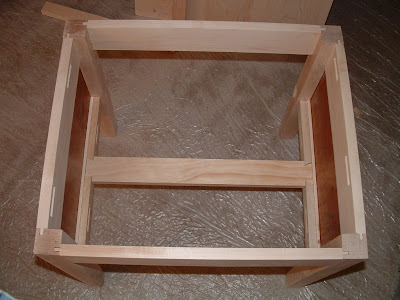After I moved out of the apartment, my woodworking stuff was packed away for quite a while until we could build our house. Once it was built and we moved in, getting my workshop in shape was not the highest priority, but I eventually got it set up as described in my earlier post.
I no sooner had it set up and started to work on a possible tool chest, and my wife became pregnant. We had a very "interesting" pregnancy which ended up turning out well, but we had a healthy premature baby to visit in the hospital for 6 weeks and then take care of for quite a while longer. Basically, I didn't get diddly squat done for a couple of years.
Then we needed a step stool for our son to be able to reach the sink. Sure, I thought, that would be an easy one. I took the old glued up panels I had made out of borg poplar and cut them down to make the sides and treads of the step stool.
 |
The hardest part was getting the sides cut down even and straight. If I had started out and glued up the sides from scratch it would have been much, much easier. I dovetailed the treads in and stuck a cross post in at the bottom of the front to keep it from spreading.
 |
And that's dovetailed into the sides as well. It was dovetail practice time.
 |
I was rusty, but it turned out pretty good. It's a little high for its footprint so can be a little tippy if you're not careful, but I could now build another one in half the time.
With one more project success under my belt I convinced my wife that we needed a bookshelf in the kitchen for the cook books. I went a little crazy in the lumber store and decided to make it out of 4/4 curly maple.
 |
It's a pretty simple design, and I had to make it to definite dimensions so that it fit in a specific place, but I still managed to screw it up a bit. I cut the last shelf just 1/2" too short, and since my wood stretcher isn't working these days, I had to go buy one more board for the last shelf. Very frustrating.
But it also turned out ok. I did wedged tenons to hold the bottom shelf to the sides. I did have some measurement challenges and ended up making the top shelf too short for anything but my son's kid books and a couple of other odds and ends.
< |
But the wood is beautiful (Danish oil and wax finish) and the dovetails in the 4/4 material turned out pretty good as well. Overall I'm happy with it despite the few mistakes I know I made.
 |
 |
So, that brings us to the present day. With this incredibly extensive resume of woodworking projects, I decided that I was ready to tackle a new challenge. I got Christopher Schwarz's workbench book and fell totally in love with the Roubo bench. With no real fear, or enough sense to know any limitations, I decided to go for it. But that's another, and longer story, that's still going on. I'll start that in my next post.
AAAndrew



















